Growing Pachysandra from Cuttings
I am growing pachysandra from cuttings. That doesn’t sound too hard, does it?
Pachysandra is an easy to grow, lush, shade-tolerant ground cover that many people use to reduce lawn or to fill in places where grass won’t grow. My weed-filled lawn is driving me crazy—I’d work harder at it but there simply is too much of it. And since I refuse to use pesticides, some of the grass has got to go.
This project actually started two years ago (see pictures here). I mail-ordered some pachysandra and when the bare-rooted plants arrived, we planted, mulched, then waited for them to overtake the north side of the house. They didn’t die but two years later, we are still waiting for that lush profusion part.
Clearly this isn’t working.
So I went back to the internet for advice and learned that if I rooted cuttings, I could create more plants—for free! I read everywhere that you needed to dip the cuttings in rooting hormone so I went out and bought some rooting hormone. And then I read the label…
Label (paraphrased): Keep away from pets and children. Use gloves when handling. Dispose of as hazardous waste?!
Now I don’t know if they were just being alarmist but these warnings made me think twice. But I’d already spent the money and I was not going to throw it out. So (under the circumstances) I decided to do a (loosely) controlled experiment. I would root some cuttings using the rooting hormone and some in plain water. I didn’t get science training for nothing!
Growing Pachysandra Instructions (Methodology)
I took cuttings that were about 5-6 inches in length, then removed the lower 2-3 inches of leaves. Divided them into two groups to be tested with either rooting hormone or plain water.
- Rooting Hormone: Wearing gloves, dipped the cut end in rooting hormone, then inserted in seed starting mix. Watered and encased in plastic tent, then waited for 6?? weeks (oops, incomplete notes, but pachysandra are notoriously slow to root). Planted outdoors (wearing gloves). Plants all survived.
- Plain water: Slipped cuttings into empty 1 quart yogurt container with water covering bottom couple inches. Checked water regularly and refilled as needed, while waiting 6?? weeks (oops again) for root development. Planted outdoors. Plants all survived.
With my Growing Pachysandra from Cuttings experiment completed, it was time to summarize the results:
- Rooting Hormone: Worked well, more expensive (though less than buying new plants), per the warning, one would conclude it is potentially harmful for the environment–and me
- Plain Water: Worked well, free, safe.
Now clearly, I think we have a winner! Isn’t science fun!
Ooooo, I feel just like the gardening version of America’s Test Kitchen!

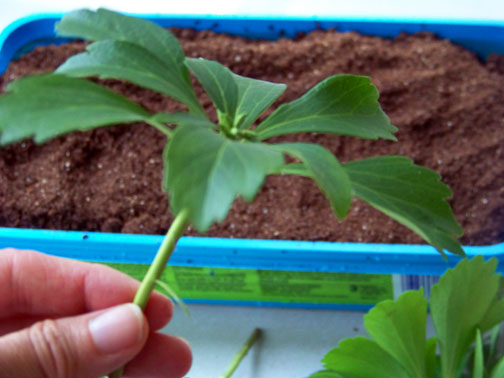
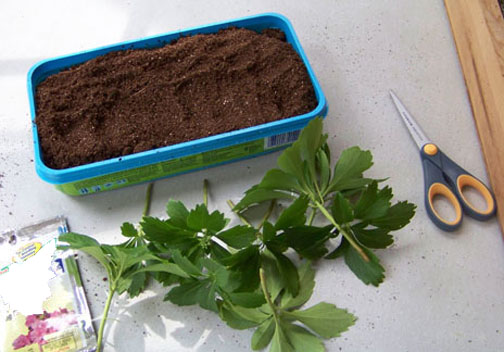
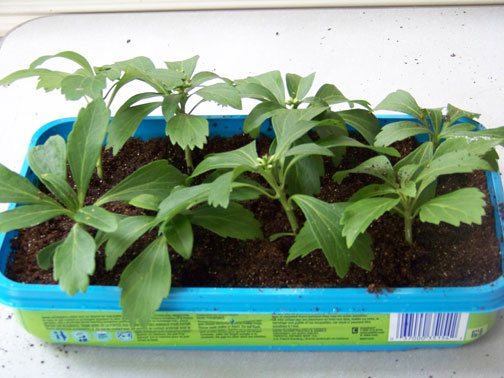
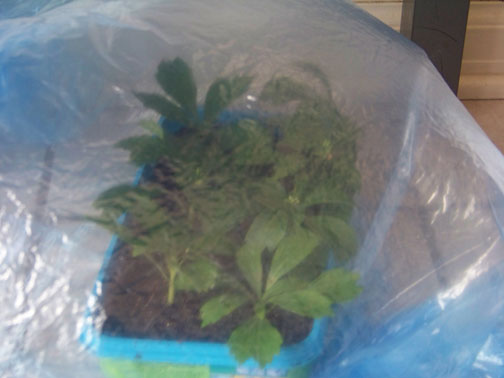
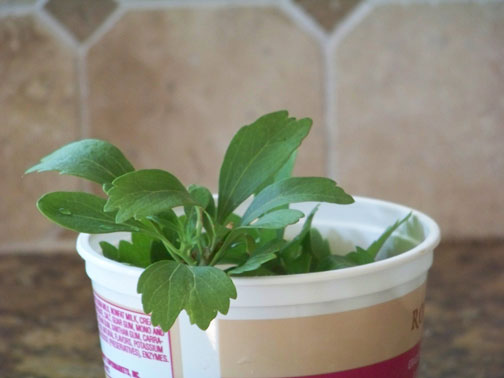
In the fall lace the leaves which you have raked into the bed. Gradually they will break up and make compost. Also protects the plants and roots from snow. My dad taught me that one! Have used some of his plants to start a bed and every day I remember him as I enjoy this wonderful gift.
Christy
Thanks for the tip Christy! What a wonderful way to remember your father!
I have a small garden patch with Hosta and vinca, also I have been trying to grow Pachysandra. For many years I have been trying this, it is slightly shady, under a maple tree.
If I plant 20 a year later I will have 5-8 left. I have amended the soil with compost, ground up lobster shells, stream sediment, etc. Other places in my yard it grows pretty well but nowhere is it lush. My basic soil is clay predominate. Any ideas? All my neighbors can grow this without effort.
Thanks. [email protected]
Oh dear, you really aren’t getting good reward for all you efforts are you! Is yours possibly getting too much sun? You mentioned “slightly shady”–do you see any evidence of “sun burn”? At this point you might just want to try another plant :). I also like Sweet Woodruff under my trees, so that’s a possibility.
Thanks for this. I put a cutting in water a few days back and didn’t see anything happening. You know how some plants start growing roots right away. Then it occurred to me to look online. I ran across the root hormone method first and it seemed like a pain. Glad to find that I can hope to root my cuttings in 6 weeks using plain water. I don’t have any yogurt containers. Hope a cheese spread container will work as well 😉
Cheese spread container, old soup can, whatever! Good luck!
A few years later but thanks for this. Your method works and is free, which makes it even better!
So happy you had success–and thanks for letting me know!
How long can pachysandra survive without soil before transplanting?
I know that I’ve gotten busy and left them a couple weeks (or longer??) after they had perfectly fine roots. The longer you leave them, the more plants that will die, so its best to plant them as soon as they are ready. I’m so often late though, that I always cut extras to start 🙂 .
I have found I have close to 100% success propagating pachysandra simply cutting off the to 4 to 5 inches of any stem above its first leaflets and using the 16″ long forked garden tool designed to punch a 3+ inch deep holes in the soil in which to plant each cutting. Gently press together the soil around each planted cutting. Plant 10 to 30 cuttings together in one area at any one time and then water them together by flooding the area. I plant them 4″ to 5″ apart because the planting is already attractive within a few days.
This is the second time I’ve heard this Hans. I am going to have to give this a try some time when I can pay good attention to the watering! It would certainly be the easiest way to go! Thanks for sharing!
If you have lots of pachysandra to begin with like I do, after trimming it back to widen several hundred feet of paths each spring, then not much fussiness is need to fill in new areas with it….I’m talking rough cuttings, big and little, pachysandra leaves and twigs, etc. trimmed using a hedge shears gathered into a large garbage bag…..Then planting….Push a shovel into the ground, force the shovel up and outward forming a large divot, toss a handful of mix from the bag into the “hasty” hole, remove the shovel carefully, lightly tamp down the planting, and go to the next dig……It works… …….I now have over a thousand square feet of pachysandra ground cover having purchased only one tray to start………….Of course it does take a few years to get to that point, so if you are not going to stay put for a while, don’t bother.
Wow–I am envious! I still need to do careful cuttings, but I may try planing a couple cuttings without rooting first and see how that goes. Thanks Walter!
Awesome! Thanks so much
Greetings Inger,
I heard that honey could be used in place of rooting hormone. I have not tried it yet but wouldn’t that be sweet?
Good Day,
JMD
That’s an interesting idea Joseph–and I always have raw honey around. If I try rooting some things that are particularly difficult in the future, I may have to try that. Thanks for commenting!
Rooting powder is 99% or more talcum powder, 1% or less rooting hormone. I’ve been using it for 30 years and I can assure you it is harmless.
Well that’s reassuring Randy. You do never know if the warnings are real or more CYA… In any case it’s nice to know I don’t need to lay out the cash for it since plain water works so well!
Should you cut off many of the leaves for faster root growth ????????
I believe that you should cut off the leaves below the water so they don’t rot, but that the others should stay on so they can produce food for the cutting.
This was useful to read- thanks Inger!
I am glad it was helpful to you!
I have some rooting hormone, that so rarely get’s used that I’m sure its fabulously old, but now I want to know what the contents are as well. Certainly something to think about for future gardening projects – thank you !
I was certainly surprised when I read the handling directions! Not sure if they are all the same. If anything Britain may have tougher standards I would think.
Never heard of this. Thanks for sharing!
You have so many wonderful tips for growing this plant and knowledge about it, I am sure your experiement will be a success 😀
Cheers
CCU
Thank you. Victory will be marked by not mowing on the north side of the house. In a couple years I hope (sigh)…
GREAT job Inger!!! I’ve never used root hormone in my life and I’ve been pretty successful with “making babies” from plants. I think it sometimes depends on the plant too. For instance, where you cut it. I know in order to root a Butterfly Bush, you need to cut below the Y and make sure you keep it immersed in water until leaves form. It won’t get roots but when the leaves form, it can be planted. It even works with the hybrids!
I’m not a huge fan of Pachysandra but as you expect, once on it’s way to growing, it does cover quickly. Quite frankly, I’m not a big fan of lawns either. But, that’s a complaint for another day, lol…Thanks for sharing and Good Luck!!!
We used to root cuttings all the time as poor college students. I don’t know why I didn’t try that first. Probably so used to researching everything on the internet that I ignored the obvious!
I should also ask if there is something you prefer to Pachysandra (in case I get tired of little yogurt containers all over)…
Very interesting article. Wonderful experiment. My yard could use some pachysandra plants, but doubt if they would take root at all in this rain-starved desert-looking soil. Rain is so desperately needed here in the Foothills. Trees are going dormant. Farmers may not grow enough hay for their farm animals.
Perhaps there is something else that might work in your climate? We’re approaching drought ourselves now (nothing new is going in the soil for me). My heart really goes out to those impacted by the brush fires. I’ve never seen so many people hoping for rain…
Yes, Sad and scary.
hmmmm. How bout that rooting hormone? What exactly is it?
My guess is that this contains a plant hormone to spur root development and also a fungicide to deter fungal growth. Since I have no plans to buy this again, I didn’t bother to check if there is a different product that might be preferable. Seems like some plants might truly need that “extra push” so I may have to look deeper in the future if I ever propagate more challenging plants. But the Pachysandra is a cinch–don’t know why the websites don’t tell people this.
I wish there was a gardening version of America’s Test Kitchen, that’s definitely a show I would watch!
That would be fun, wouldn’t it!
Dip end of cutting in honey ( organic) plant in rotten potatoe, or part of , and plant in soil . No need for rooting powder.
Another novel approach!